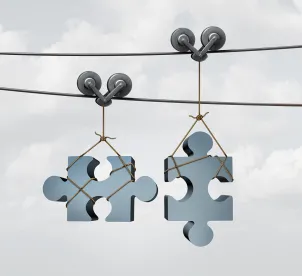In September 25, 2018 remarks at the 2018 Global Antitrust Enforcement Symposium, Assistant Attorney General Makan Delrahim announced the Department of Justice’s (DOJ) plan to modernize and expedite the DOJ merger review process. Delahim committed the DOJ to attempt to complete merger reviews within six months of the parties’ Hart-Scott-Rodino (HSR) filings.
Delrahim acknowledged that significant merger reviews are increasingly taking longer to complete. In 2013, significant merger reviews took on average 7.1 months to complete, while in 2017, the average length of a review was 10.8 months – a 65% increase in just five years.
Delrahim suggested several factors that contributed to the increased length of reviews. First, in a world of big data, the merging parties maintain enormous quantities of data, which, in turn, results in lengthy productions and reviews. Second, because of globalization, more and more mergers necessitate foreign coordination, which takes time and resources. Third, if a divestiture is necessary to remedy anticompetitive elements of a transaction, the Division has often required pre-approved, upfront buyers before a consent decree can be filed.
Delrahim stressed the DOJ’s goal should not be to delay procompetitive or neutral mergers. With this goal in mind, he announced the following improvements to the merger review process:
- Meet With the Parties Early. The Antitrust Division Front Office will be open to an initial, introductory meeting. Parties should try their best to include key executives. By including key executives, the DOJ will better be able to understand the deal rationale and other important facts.
- Model Voluntary Request Letter. The Division routinely asks for the voluntary production of key information during the initial waiting period. In order to better inform merging parties about the kinds of information they will need to provide, the Division plans to publish a model voluntary request letter on its website.
- Pull-and-Refile Accountability. Rather than face a second request, parties have the option to pull and refile their HSRs. To avoid wasting time, the Division will now track what happens after the parties pull and refile, with the goal of developing an investigation plan during this period of time.
- Model Timing Agreement. The Division also plans to publish a model timing agreement on its website in order to better inform parties about the timing agreement negotiation process. Delrahim stressed that too often negotiations over timing agreements take on a life on their own, resulting in the parties and the Division spending too much time on the process, rather than the heart of the problem. With the model timing agreement, the Division hopes parties will be better prepared to quickly negotiate the agreement.
- Reforming Scope and Timing of Investigations. The Division acknowledges the timing agreements are not part of the process outlined in the HSR Act. The Act provides a thirty day deadline for the Division to decide after the parties have certified compliance with the second request. As a result, the Division will strive to improve the model timing agreement to align the process more closely with the HSR Act. Delrahim provided the following examples of likely improvements:
- Fewer Custodians. The Division will request documents from fewer custodians. It will assume twenty custodians per party is sufficient unless the Deputy AAG in charge of the investigation authorizes additional custodians.
- Fewer Depositions. The Division will not seek more than twelve depositions unless the Deputy AAG in charge of the investigation authorizes additional depositions.
- Shorter Time from Compliance to a Decision. The Division will make a decision no longer than sixty days after the parties certify compliance unless the Deputy AAG in charge of the investigation authorizes additional time.
In return, merging parties are expected to assist meeting the improved timing objectives for HSR reviews:
- Faster and Earlier Productions of Documents. Generally speaking, the Division will expect to receive documents earlier in the compliance period. For traditional document reviews, the parties will produce several batches of documents throughout the compliance period. For technology assisted document reviews, the parties will complete the majority of the production a certain number of days in advance of certifying full compliance.
- Earlier Production of Data. Because data is easier to produce than documents, the Division expects production of useable data well before the second request compliance date.
- No More Privilege Log Gamesmanship. Delrahim noted that too often parties withhold a large number of documents as privileged, but then de-privilege many of these documents much later in the process, often on the eve of a particular deposition. As a result, he requested the parties stop gaming the system and start respecting the spirit of the privilege log process.
- Longer Post-Complaint Discovery Process. The Division will require adequate time to conduct post-complaint discovery in the event that it results in contested litigation.
- CID Enforcement. The Division intends to hold CID-recipients to the deadlines and specifications in the CIDs. Too often compliance with CIDs is slow and incomplete.
Delahim suggested other “reforms” and “initiatives” in connection with merger reviews:
- Demonstrating Leadership in Parallel Investigations. Where possible, the Division will seek to coordinate with foreign enforcers in parallel investigations. In addition, when the parties are facing a parallel investigation, they should consider aligning their time periods with other jurisdictions, if possible.
- Withdrawing the 2011 Remedies Guide. The Division is currently reviewing its practices regarding remedies, with, like the other changes, the goal of expediting the process. Significantly, Delrahim announced the withdrawal of the 2011 Policy Guide to Merger Remedies. Until the updated Policy Guide is implemented, the 2004 Policy Guide will be in effect.
- Release of Merger Review Statistics. In order to assess whether these changes are effective, the Division will release the average duration of second request investigations and the average length of time from the opening of a preliminary investigation to the early termination or closing of the investigation, including investigations that did not result in a second request.
These changes are no panacea. Substantive merger reviews at the DOJ will remain lengthy, intrusive, and expensive. The Division expects more documents, data, and other information more quickly as well as greater involvement of the merging parties’ key personnel. The six month shot clock is aspirational — the Federal Communications Commission several years ago imposed upon itself a similar shot clock for its merger reviews of transactions also under its jurisdiction, but has often found reasons to pause the shot clock over completeness issues. Although incremental, the changes are all in the right direction and should be welcomed. It can be expected that the Federal Trade Commission will update its merger review process as well.
Delrahim’s full remarks are available here.





 />i
/>i

